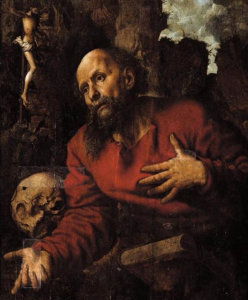The Habitats of Jerome. The author (Alison Smithson) is trying to analyse and conceive the allegory of the habitats of saint Jerome. People realised that the three habitats can be perceived as allegories came a thousand years after Jerome’s death, during the renaissance. At the time, the habitats became o topic of interest for lots of painters trying to depict the habitats themselves and also the allegory.
The Desert. The habitat that saint Jerome chose to start his journey was the desert. In the desert he became distant with the civilised world as well as the interaction with other people. He went there to think and pray. The desert symbolises the nature – the wild. During that time he became one with the nature, he embraced it.
The Study. The study was the second environment of saint Jerome. In the paintings he is depicted in a cave with many books. After the desert, Jerome wanted to become part of a community as well as enjoy a closed environment without being exposed to weather phenomena – man-made. he started socialising as well as embracing environments completely opposite of his previous one, the desert.
The Grotto. The grotto was Jerome’s last environment. The grotto is the the desert and the study combined. After experiencing the two ends of the spectrum and tried to find what is the best environment in between. The grotto symbolises both the wild and the man made. It is the idyll environment to live.
Possible Research Topic. How architecture interact with its natural environment as well as how the user embraces the architectural environment in relation to the natural environment.

